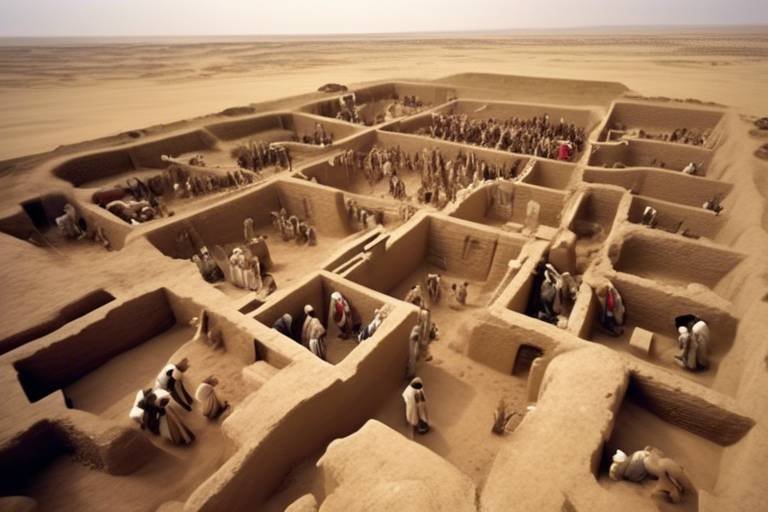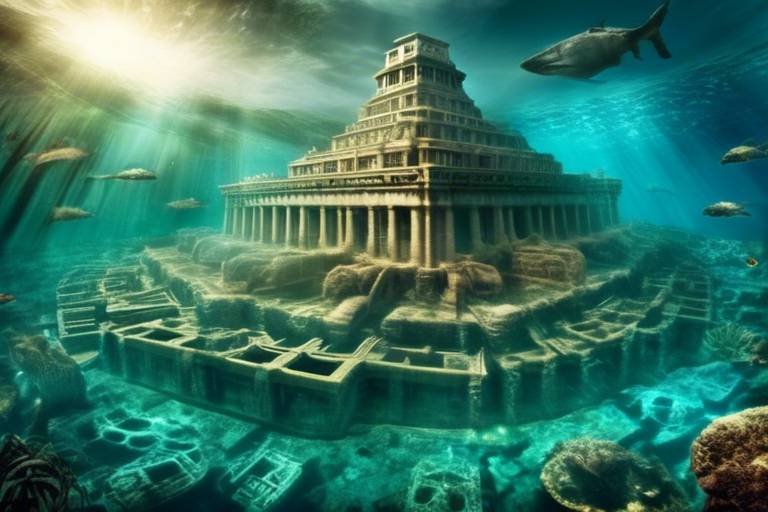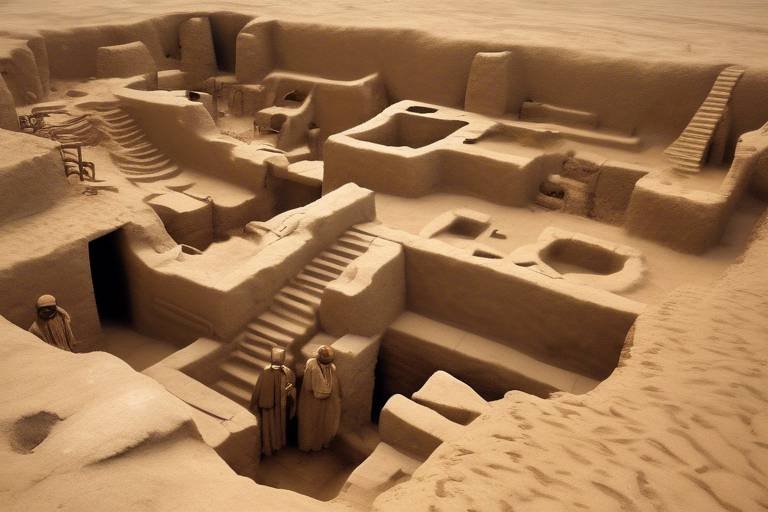Machu Picchu - Secrets of the Inca Civilization
Exploring the mysteries and marvels of Machu Picchu, an ancient Inca citadel nestled in the Andes Mountains of Peru, revealing insights into the advanced civilization that once thrived there.
Uncovering the fascinating story of Hiram Bingham's 1911 expedition that brought Machu Picchu to the world's attention, leading to its recognition as a UNESCO World Heritage Site.
Delving into the sophisticated architectural techniques and engineering marvels employed by the Incas to construct the intricate stone structures of Machu Picchu.
Exploring the purpose and significance of the enigmatic Inti Watana stone structure, believed to have served astronomical and ceremonial functions in Inca society.
Examining the innovative agricultural terraces and intricate water management systems that sustained the agricultural productivity of Machu Picchu at high altitudes.
Unveiling the religious and spiritual beliefs of the Incas as reflected in the sacred temples, shrines, and ceremonial spaces found throughout Machu Picchu.
Discovering the architectural grandeur and astronomical alignments of the Temple of the Sun, a revered religious site dedicated to the Inca sun god, Inti.
Exploring the evidence of ritualistic practices, including sacrifices and offerings, that were integral to the religious ceremonies conducted by the Inca priests at Machu Picchu.
Tracing the enigmatic circumstances surrounding the abandonment of Machu Picchu and the subsequent rediscovery of the ancient citadel, shedding light on its enduring allure and mystery.

Discovery of Machu Picchu
Exploring the mysteries and marvels of Machu Picchu, an ancient Inca citadel nestled in the Andes Mountains of Peru, revealing insights into the advanced civilization that once thrived there.
Uncovering the fascinating story of Hiram Bingham's 1911 expedition that brought Machu Picchu to the world's attention, leading to its recognition as a UNESCO World Heritage Site.
During his quest to find the lost city of Vilcabamba, Bingham stumbled upon the hidden gem of Machu Picchu. The lush greenery and majestic stone structures stood as a testament to the ingenuity of the ancient Inca civilization. The world was captivated by the beauty and mystery of this secluded citadel, sparking a wave of interest in Inca history and culture.
Bingham's expedition not only unearthed the physical remains of Machu Picchu but also brought to light the rich heritage and architectural wonders of the Incas. The intricate stonework, terraced fields, and ceremonial spaces revealed a society that was deeply connected to the natural world and the cosmos.
The discovery of Machu Picchu marked a turning point in our understanding of ancient civilizations and their achievements. It opened a door to a world shrouded in mystery and intrigue, inviting us to delve deeper into the secrets of the past.
Delving into the sophisticated architectural techniques and engineering marvels employed by the Incas to construct the intricate stone structures of Machu Picchu.
Exploring the purpose and significance of the enigmatic Inti Watana stone structure, believed to have served astronomical and ceremonial functions in Inca society.
Examining the innovative agricultural terraces and intricate water management systems that sustained the agricultural productivity of Machu Picchu at high altitudes.
Unveiling the religious and spiritual beliefs of the Incas as reflected in the sacred temples, shrines, and ceremonial spaces found throughout Machu Picchu.
Discovering the architectural grandeur and astronomical alignments of the Temple of the Sun, a revered religious site dedicated to the Inca sun god, Inti.
Exploring the evidence of ritualistic practices, including sacrifices and offerings, that were integral to the religious ceremonies conducted by the Inca priests at Machu Picchu.
Tracing the enigmatic circumstances surrounding the abandonment of Machu Picchu and the subsequent rediscovery of the ancient citadel, shedding light on its enduring allure and mystery.
Coming soon...

Inca Architecture and Engineering
Exploring the mysteries and marvels of Machu Picchu, an ancient Inca citadel nestled in the Andes Mountains of Peru, revealing insights into the advanced civilization that once thrived there.
Uncovering the fascinating story of Hiram Bingham's 1911 expedition that brought Machu Picchu to the world's attention, leading to its recognition as a UNESCO World Heritage Site.
Delving into the sophisticated architectural techniques and engineering marvels employed by the Incas to construct the intricate stone structures of Machu Picchu.
Exploring the purpose and significance of the enigmatic Inti Watana stone structure, believed to have served astronomical and ceremonial functions in Inca society.
Examining the innovative agricultural terraces and intricate water management systems that sustained the agricultural productivity of Machu Picchu at high altitudes.
Unveiling the religious and spiritual beliefs of the Incas as reflected in the sacred temples, shrines, and ceremonial spaces found throughout Machu Picchu.
Discovering the architectural grandeur and astronomical alignments of the Temple of the Sun, a revered religious site dedicated to the Inca sun god, Inti.
Exploring the evidence of ritualistic practices, including sacrifices and offerings, that were integral to the religious ceremonies conducted by the Inca priests at Machu Picchu.
Tracing the enigmatic circumstances surrounding the abandonment of Machu Picchu and the subsequent rediscovery of the ancient citadel, shedding light on its enduring allure and mystery.

Inti Watana - The Hitching Post of the Sun
Exploring the mysteries and marvels of Machu Picchu, an ancient Inca citadel nestled in the Andes Mountains of Peru, revealing insights into the advanced civilization that once thrived there.
Uncovering the fascinating story of Hiram Bingham's 1911 expedition that brought Machu Picchu to the world's attention, leading to its recognition as a UNESCO World Heritage Site.
Delving into the sophisticated architectural techniques and engineering marvels employed by the Incas to construct the intricate stone structures of Machu Picchu.
The Inti Watana stone structure, known as the Hitching Post of the Sun, holds a significant place in Inca culture. It is believed to have served both astronomical and ceremonial purposes, aligning with the movements of the sun and stars. This sacred site was likely used for rituals and ceremonies, symbolizing the connection between the heavens and the earth for the Inca people. The precise positioning of the Inti Watana stone reflects the advanced astronomical knowledge of the Incas, showcasing their reverence for celestial bodies and their intricate understanding of the cosmos.
Examining the innovative agricultural terraces and intricate water management systems that sustained the agricultural productivity of Machu Picchu at high altitudes.
Unveiling the religious and spiritual beliefs of the Incas as reflected in the sacred temples, shrines, and ceremonial spaces found throughout Machu Picchu.
Discovering the architectural grandeur and astronomical alignments of the Temple of the Sun, a revered religious site dedicated to the Inca sun god, Inti.
Exploring the evidence of ritualistic practices, including sacrifices and offerings, that were integral to the religious ceremonies conducted by the Inca priests at Machu Picchu.
Tracing the enigmatic circumstances surrounding the abandonment of Machu Picchu and the subsequent rediscovery of the ancient citadel, shedding light on its enduring allure and mystery.

Agricultural Terraces and Water Management
When it comes to the agricultural terraces and water management systems of Machu Picchu, one can't help but marvel at the ingenuity of the Inca civilization. These terraces, known as "andenes," were not just simple farming platforms but rather sophisticated structures designed to maximize agricultural productivity in the challenging mountainous terrain.
The Incas ingeniously utilized a system of interconnected agricultural terraces that not only prevented soil erosion but also allowed for efficient water distribution across different levels. These terraces were built with precise angles to capture sunlight and retain heat, creating microclimates ideal for growing a variety of crops at varying altitudes.
Moreover, the intricate network of channels and aqueducts showcased the advanced water management skills of the Incas. They ingeniously channeled water from natural sources, such as springs and rivers, to irrigate the terraces, ensuring a steady water supply for cultivation.
By carefully controlling water flow and distribution, the Incas were able to cultivate crops such as maize, potatoes, quinoa, and various medicinal plants at altitudes where traditional farming would have been impossible. This agricultural success not only sustained the inhabitants of Machu Picchu but also demonstrated the Inca's deep understanding of the land and environment.

Religious and Spiritual Significance
Delve into the mystical world of Machu Picchu, where the ancient Incas left behind a legacy of religious and spiritual significance that continues to captivate visitors to this day. The citadel's sacred temples, shrines, and ceremonial spaces offer a glimpse into the intricate belief system of the Incas, revealing their deep connection to the natural world and the cosmos.
At the heart of Machu Picchu lies the revered Temple of the Sun, a testament to the Inca's devotion to Inti, the sun god. This architectural marvel not only showcases the Inca's advanced knowledge of astronomy but also serves as a place of worship where they paid homage to the source of life and light.
Within the sacred precincts of Machu Picchu, evidence of sacrificial rituals and offerings sheds light on the spiritual practices of the Inca priests. These ceremonies, involving the sacrifice of animals and possibly humans, were believed to appease the gods and ensure the prosperity of the empire.
The religious and spiritual significance of Machu Picchu extends beyond the physical structures, permeating the very essence of the citadel. Every stone, every carving, and every alignment was imbued with symbolic meaning, reflecting the Inca's profound reverence for the divine forces that governed their lives.

Temple of the Sun
The stands as a testament to the Inca civilization's architectural prowess and spiritual devotion. Set atop Machu Picchu with breathtaking views of the surrounding mountains, this sacred site was dedicated to the worship of Inti, the Inca sun god. The temple's design, characterized by meticulously crafted stone walls and precise alignments with the sun's movements, showcases the Inca's deep connection to the celestial bodies and their religious beliefs.
Within the Temple of the Sun, intricate carvings and niches are believed to have held ceremonial objects and offerings, symbolizing the Inca's reverence for the sun and their rituals of gratitude. The strategic positioning of the temple allowed sunlight to illuminate specific areas during solstices, highlighting the Inca's advanced knowledge of astronomy and their ability to integrate it into their religious practices.
Visitors to the Temple of the Sun can feel the spiritual energy that permeates the ancient stones, evoking a sense of wonder and awe at the ingenuity and devotion of the Inca people. As the sun's rays filter through the temple's windows and doorways, casting intricate patterns of light and shadow, one can't help but marvel at the harmonious blend of nature, architecture, and spirituality embodied in this sacred space.

Sacrificial Rituals and Offerings
Exploring the intriguing practices of sacrificial rituals and offerings sheds light on the religious ceremonies conducted by the Inca priests at Machu Picchu. These rituals were integral to the spiritual beliefs of the Incas, reflecting their deep connection to the divine and the natural world. The act of offering sacrifices, whether of animals or occasionally humans, was believed to appease the gods and ensure the prosperity and protection of the community.
The sacrificial rituals at Machu Picchu were not carried out lightly; rather, they were imbued with profound significance and solemnity. The Inca priests, known as amautas, meticulously prepared for these ceremonies, invoking the blessings of the deities and seeking guidance through divination practices. The offerings made during these rituals ranged from prized llamas and other animals to intricate textiles, ceramics, and food items.
One of the most notable aspects of the sacrificial rituals at Machu Picchu was the careful selection of participants and offerings. The individuals chosen for sacrifice were often young and physically perfect, symbolizing purity and strength. These individuals were honored to be selected for such a sacred purpose, believing that their sacrifice would ensure the well-being of their community and secure a favorable relationship with the gods.
Furthermore, the locations where these rituals took place within Machu Picchu were carefully chosen for their spiritual significance and alignment with celestial events. The Temple of the Sun, with its precise astronomical alignments, served as a central site for many of these ceremonies, emphasizing the connection between the earthly realm and the heavens.
Through the examination of archaeological evidence and historical accounts, modern scholars continue to unravel the mysteries surrounding the sacrificial rituals and offerings at Machu Picchu. These practices offer a glimpse into the complex belief system of the Inca civilization, highlighting their reverence for nature, the cosmos, and the divine forces that shaped their worldview.

Abandonment and Rediscovery
After centuries of thriving as a vibrant hub of Inca civilization, Machu Picchu faced a mysterious fate that led to its abandonment. The precise reasons behind the desertion of this majestic citadel remain shrouded in mystery, sparking endless speculation and intrigue among historians and archaeologists. Some theories suggest that the spread of diseases brought by Spanish conquistadors, internal strife, or natural disasters could have played a role in the sudden departure of the Inca population from Machu Picchu.
For centuries, Machu Picchu lay hidden from the world, its existence fading into obscurity as nature slowly reclaimed the ancient stone structures. It wasn't until the early 20th century that the lost city of the Incas resurfaced, thanks to the determined efforts of American explorer Hiram Bingham. In 1911, Bingham embarked on an expedition in search of the legendary Vilcabamba, the last refuge of the Incas, and stumbled upon the breathtaking ruins of Machu Picchu.
The rediscovery of Machu Picchu marked a turning point in the history of archaeology, unveiling a trove of invaluable insights into the advanced Inca civilization. The meticulous documentation and preservation efforts that followed Bingham's expedition ensured that Machu Picchu would be recognized as a UNESCO World Heritage Site, safeguarding its legacy for future generations to marvel at.
Today, the enigmatic allure of Machu Picchu continues to captivate visitors from around the globe, drawing them into a world of ancient mysteries and architectural marvels. The abandoned citadel stands as a testament to the ingenuity and resilience of the Inca people, inviting us to ponder the secrets that lie buried within its stone walls and terraced slopes.
Frequently Asked Questions
- What is the significance of Machu Picchu?
Machu Picchu is a remarkable ancient Inca citadel that offers insights into the advanced civilization that once thrived there. It served as a religious, ceremonial, and agricultural center, showcasing the architectural and engineering prowess of the Incas.
- How was Machu Picchu discovered?
Machu Picchu was brought to the world's attention through the efforts of Hiram Bingham, an American explorer, in 1911. His expedition led to the recognition of Machu Picchu as a UNESCO World Heritage Site, unveiling its historical and cultural significance.
- What architectural marvels can be found at Machu Picchu?
Machu Picchu boasts intricate stone structures, such as the Temple of the Sun and Inti Watana, showcasing the advanced architectural techniques of the Incas. The site also features agricultural terraces and water management systems that highlight their ingenuity.
- What was the religious significance of Machu Picchu?
Machu Picchu was a sacred site for the Incas, with temples, shrines, and ceremonial spaces dedicated to their religious and spiritual beliefs. The presence of sacrificial rituals and offerings reflects the importance of religious practices in Inca society.
- Why was Machu Picchu abandoned?
The reasons for the abandonment of Machu Picchu remain a mystery, with theories ranging from environmental challenges to political unrest. Despite its abandonment, the rediscovery of Machu Picchu has contributed to its enduring allure and fascination.



















